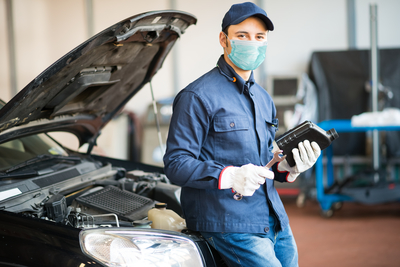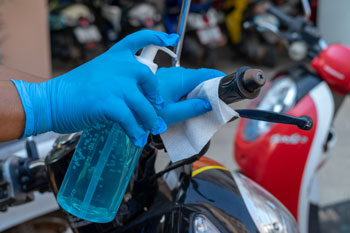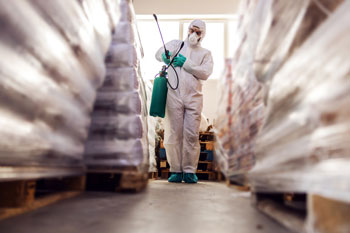Emerging Best Practices and Resources to Protect Employees and Customers
 As the nation shifts into recovery mode from the COVID-19 pandemic, businesses throughout the aftermarket are faced with creating safer environments for employees and customers. Fortunately, there are a number of best practices emerging to meet the challenge. |
Even in the early days of the COVID-19 pandemic, the aftermarket was rolling up its sleeves for business. For operations able to stay open under essential-business declarations, that meant adopting the latest best practices in coronavirus mitigation. For those unable to stay open, it meant crafting innovative strategies to weather the lockdown until the green light came to reopen. Now that the economy is shifting into recovery mode, businesses in the latter category may be asking what “safely reopening” means. How can they best protect the health of employees and customers alike?
Given the patchwork of policy guidelines set forth at the national, state and local levels, there is no one-size-fits-all answer to that question. However, there are a number of best practices that can serve as general models.
Cushman & Wakefield, a commercial real-estate services firm, has made a new white paper available online entitled “Recovery Readiness: A How-To Guide for Reopening Your Workplace.” The comprehensive guide includes detailed checklists tailored to both retail and warehouse environments to help inform sound reopening strategies. While the recommendations are extensive, they are scalable for businesses of all sizes and can be summed up in the following six steps:
- Prepare the Building: Cleaning plans, pre-return inspections, HVAC and mechanical checks to ensure the safety of all workers. This step includes the use of approved cleaning products and following compliance procedures from the relevant governing authorities.
- Prepare the Workforce: Creation of policies for deciding who returns and when, along with employee communications to help mitigate disruptions and employee anxieties. This will include assessments of who can benefit from returning to the work site and who can benefit from continuing to work remotely, along with training in social distancing for returning workers.
- Control Access: Identify access points to the business (including deliveries) and create protocols for safety and health screening of visitors. Install protective measures such as plexiglass shields and sanitizer stations where appropriate.
- Create a Social-Distancing Plan: Identify ways to decrease density through schedule management, changing office traffic patterns and other measures.
- Reduce Touch Points and Increase Cleaning: Create enhanced cleaning policies for all entries and exits to key areas, employee desks, food areas, and common areas and surfaces.
- Communicate for Confidence: Recognize the anxiety associated with returning, communicate transparently, and listen and survey employees regularly with an emphasis on helping them feel secure.
 One of the major factors in reopening will be communicating to employees and customers the steps your business is taking to maintain safety. Make sure that such communications go two ways so that you can swiftly address any concerns or anxieties that might impede business recovery. |
Industry Examples
Although the Cushman & Wakefield recommendations offer excellent guidelines for most warehouse and retail situations, automotive specialty-equipment businesses present some unique challenges, especially in their manufacturing, service and installation environments. Fortunately again, there are a number of automotive-related companies adopting best practices that can serve as industry examples.
Performance clutch manufacturer Centerforce, based in Prescott, Arizona, was able to remain open and fully operational throughout the national shutdown as an essential business. However, that also meant taking extra precautions to ensure the safety of employees and customers.
According to Bryan Wilson, the company’s general manager for marketing, the adjustments were not overly difficult, given the company’s ample facility and manageable workforce. Because most of the workers are assigned to one machine with limited touch points throughout their shifts, the possibility of cross-contamination is low to begin with.
“We have 25 employees currently, so keeping them spread out and past the 6-ft. limit is fairly easy to do,” Wilson noted. “Different managers and other staff go around every morning and disinfect everything. In between, [workers] are also wiping down anything that they use and touch, and that’s been pretty much standard. We are keeping a very close eye
on it.”
The plant has multiple lunch shifts, which limit the break room to about two people at a time with plenty of space between them. Centerforce also reallocated its office space, splitting up employees and spreading them out.
“It’s comfortable for everyone,” Wilson explained.
Meanwhile, Yokohama Corp. of North America opted to reopen its West Point, Mississippi, truck tire manufacturing plant in late April after a brief closure. To ensure worker safety, the tire manufacturer implemented several new procedures based on the latest guidelines from the Centers for Disease Control and Prevention and local authorities. In addition to social-distancing measures similar to those deployed at Centerforce, Yokohama established new guidelines for employees returning to work. According to a company spokesperson, that included having employees stay home and contact their manager if they:
- Experienced any symptoms such as a fever, new or worsening cough, shortness of breath or flu-like conditions.
- Had a significant other or family member who traveled to an area with widespread or sustained community transmission of a case of coronavirus disease within the last 14 days.
- Had been in close contact with a person, including a healthcare worker, who had a confirmed or presumptive case of COVID-19.
The plant also suspended all large-group meetings, served only canned drinks and pre-made lunches in the employee canteen, suspended outside food and personal deliveries to the facility, and issued personal protection equipment (PPE) to all employees, with face masks to be worn at all times.
In the business-to-consumer space, retail giant Pep Boys was likewise able to continue vehicle service and parts sales throughout its U.S. locations. Accordingly, it adopted several new health-and-safety practices, including touchless drop-offs in which customers can make appointments online, park their vehicles at the service center, leave the keys in a drop box, and get service confirmations remotely.
To further minimize customer-employee contact, the retail chain also added mobile pay, with a link to work orders sent to customers via text. Following that link, customers enter credit-card information and receive a confirmation text when payments are complete.
In addition, Pep Boys service employees have adopted an “Extra Mile Care & Cleaning” program, sanitizing all high-touch surfaces at both a vehicle’s intake and prior to its return to the customer. Throughout the vehicle’s servicing, employees also utilize steering wheel covers, floor mats and PPE.
Perhaps just as importantly, Pep Boys launched a media campaign to inform consumers of the steps it was taking to enhance their safety and relieve anxieties about visiting its retail and service locations.
 The first step in reopening a business is properly preparing the building. This includes the use of approved cleaning products and following compliance procedures set by the EPA, OSHA and other relevant authorities. |
Custom Solutions
Like their retail counterparts, installation and custom/restoration shops have their own unique issues. These businesses often deal with numerous vehicle touch points, with multiple employees handling and contacting a variety of parts, surfaces and vehicle spaces as they work. In those cases, best practices being adopted by the collision-repair industry can offer
guidance.
Recently the Society of Collision Repair Specialists (SCRS) presented a webinar in which a panel of experts addressed a broad range of safety and liability issues. (The recorded webinar is now available through the SCRS coronavirus resource page at www.scrs.com/covid19-resources).
“As with everyone else, there’s a lack of familiarity with what we’re dealing with, and it’s changing on a day-by-day basis,” said Aaron Schulenburg, SCRS executive director. “That’s really challenging for an employer. In our webinar, we focused heavily on increased washing practices, things they need to do using proper disinfecting materials, donning the proper PPE, and things along the lines of keeping employees safe when entering a vehicle and knowing that they’ve done the necessary things to reasonably protect the consumer when they return it.
“Another thing that came up in the webinar was utilizing the proper safe terminologies to help a consumer understand what was done and to be cautious not to make any guarantees. There aren’t testing protocols. We can tell a consumer that we apply disinfectant, but we don’t know that we disinfected the entire vehicle. We have to make sure we communicate what was done rather than what was intended. Another big piece for our businesses is the creation of standard operating procedures that they maybe didn’t have previously.”
For some medium-to-large operations that have the resources, the best solution may be to call in outside experts. US Ecology, a leading provider of environmental services to commercial and government facilities, recently announced a COVID-19 Safe Operations Program available to businesses seeking to reopen and conduct safe operations. The program provides expert assessment of business needs and a comprehensive plan featuring strict protocols as well as cleaning and decontamination methodologies by a team of biohazard professionals. Companies wishing more information can visit www.usecology.com/coronavirus.
To sum up, the coronavirus is still a relatively unknown entity, and best practices continue to evolve. The U.S. Environmental Protection Agency (EPA) and the Occupational Safety and Health Administration (OSHA), particularly, have precise definitions and chemical guidelines for what constitutes cleaning, disinfecting or sanitizing. There are also myriad safety, legal and liability guidelines to confront. However, by adopting and adapting the best practices currently becoming industry standards, you can reopen your business in a manner that conveys safety and confidence to workers and customers alike.
| Select Resources | |
SEMA: The association continues to update its COVID-19 webpage (www.sema.org/coronavirus) to provide members with valuable resources for addressing the coronavirus. The information is comprehensive and ranges from industry best practices for protecting employee health to tracking the states as they allow nonessential businesses to reopen. Members are encouraged to bookmark the page and visit often. SCRS: The collision-repair trade association has also created a full COVID-19 resource page for industry professionals, complete with a recorded webinar on protocols and issues related to operating a safe shop or business. Visit the page at Cushman & Wakefield: Cushman & Wakefield has created a comprehensive resource webpage that includes its free downloadable white paper, “Recovery Readiness: A How-to Guide for Reopening Your Workplace,” along with downloadable retail- and warehouse-specific readiness checklists for implementation. Go to US Ecology: US Ecology has developed a COVID-19 Safe Operations Program with customized decontamination, preventative cleaning and disposal services for medium to large businesses. For information, call the 24/7 Emergency Response hotline at 800-899-4672 or visit www.usecology.com/coronavirus. |






